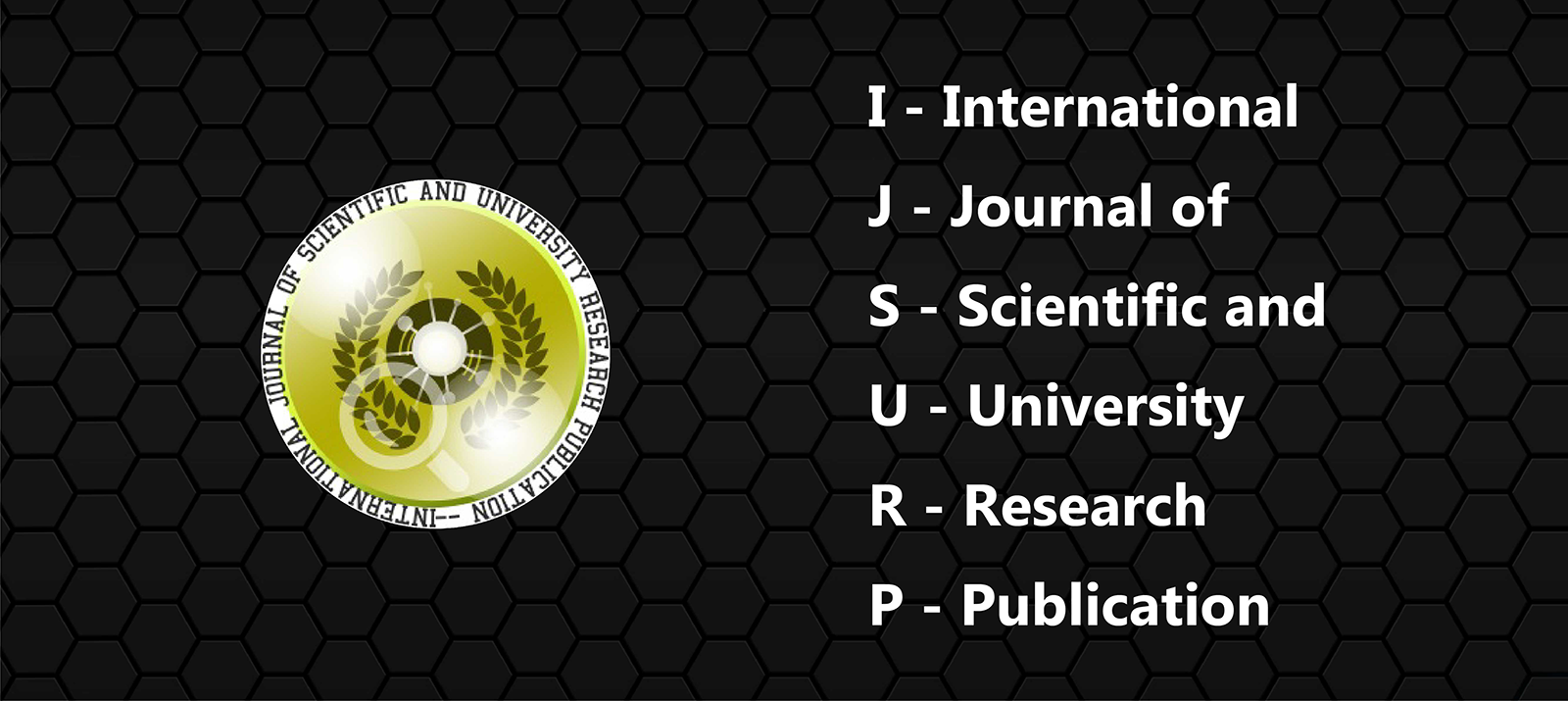
‘‘Effects of Extracts of Traditional Indian Spices, Garlic (Allium Sativum) and Ginger (Zingiber Officinale) on the Growth Rate of Escherichia Coli(E. coli) and Bacillus Subtilis (B. Subtilis).”
Authore(s) : Majithia Vanesha || Shiv Pathology LaboratorySona Cross RoadChandkhedaAhmedabad382424.
Volume : (3), Issue : 211, January - 2019
Abstract : The present study was designed to estimate antimicrobial effects of the Garlic (Allium sativum)and Ginger (Zingiber Officinale) extract. The medicinal properties of garlic and ginger were very well recognized since ancient times in India and have been used as an important constituent of Ayurvedic Medicines to cure many diseases and infections.Two potent pathogens, responsible for many infections, like food borne illness, Escherichia Coli (E.coli) and Bacillus Subtilis (B.Subtilis)were selected. The present investigation was carried out using the nutrient broth dilution method and the growths of both of these microorganisms were asessed against different volume of garlic and ginger extract respectively. Their growth was examined after 24-h by spectrophotometric analysis. The result showed that both garlic extract and ginger extract had good inhibitory action against microbial growth. Garlic extract proved to give satisfactory results as a potent inhibitory substance against both the microorganism while ginger extract showed medium activity.
Keywords :Garlic, ginger, antimicro- bial, E.coli, Bacillus sp.
Article: Download PDF Journal DOI : 2364/2018
Cite This Article:
‘Effects Ginger (Zingiber Officinale) on the Growth Rate of Escherichia Coli(E.
Vol.I (3), Issue.I 211
Article No : 10034
Number of Downloads : 100
References :
B C Nzeako, Zahra S N Al Kharousi, and Zahra Al Mahrooqui “Antimicrobial activities of Garlic and thyme extracts” Sultan Qaboos Univ Med J. (2006); 6(1): 33–39.
Chen, JawChyun; LiJiau Huang, ShihLu Wu, ShengChu Kuo, TinYun Ho, ChienYun Hsiang (2007). "Ginger and Its Bioactive Component Inhibit Enterotoxigenic Escherichia Coli HeatLabile EnterotoxinInduced Diarrhoea in Mice". Journal of Agricultural and Food Chemistry 55 (21):... More
- B C Nzeako, Zahra S N Al Kharousi, and Zahra Al Mahrooqui “Antimicrobial activities of Garlic and thyme extracts” Sultan Qaboos Univ Med J. (2006); 6(1): 33–39.
- Chen, JawChyun; LiJiau Huang, ShihLu Wu, ShengChu Kuo, TinYun Ho, ChienYun Hsiang (2007). "Ginger and Its Bioactive Component Inhibit Enterotoxigenic Escherichia Coli HeatLabile EnterotoxinInduced Diarrhoea in Mice". Journal of Agricultural and Food Chemistry 55 (21): 8390–8397.
- D Tagoe, F Gbadago. (2009).A Comparison of the Antimicrobial Effectiveness of Aqueous Extracts of Garlic, Ginger and Lime and Two Conventional Antibiotics on Escherichia coli, Salmonella spp., Shigella spp. and Bacillus cereus. The Internet Journal of Microbiology. Volume 8 Number 2.
- Fujisawa H, Suma K, Origuchi K, Kumagai H, Seki T, Ariga T. (2008).Biological and chemical stability of garlic derived allicin. J Agric Food Chem.;56(11):4229-35.
- Guo JJ, Kuo CM, Chuang YC, Hong JW, Chou RL, Chen TI. (2012). The effects of garlic supplemented diets on antibacterial activity against Streptococcus iniae and on growth in orange spotted grouper, Epinephelus coioides. Aquaculture.;33(38):364-5.
- Hiba Ali Hasan, Ayad Mohammed Rasheed Raauf, Basama Monjd Abd Razik and Bassam Abdul Rasool Hassan. (2012). “Chemical Composition and Antimicrobial Activity of the Crude Extracts Isolated from Zingiber Officinale by Different Solvents” Pharmaceut Anal Acta , 3:9.
- Kotiranta A, Lounatmaa K, Haapasalo M (2000). "Epidemiology and pathogenesis of Bacillus Cereus infections". Microbes Infect2 (2): 189–98.
- PapachanKarur Sofia., Rajendra Prasad., Virendra Kumar Vijay., Ashok Kumar Srivastava, (2007). “Evaluation of antibacterial activity of Indian spices against common foodborne pathogens” International Journal of Food Science & Technology Volume 42, Issue 8, pages 910–915.
- Roberts, T. A.; Baird-Parker, A. C.; Tompkin, R. B. (1996). Characteristics of microbial pathogens. London: Blackie Academic & Professional. p. 24.
... Less
- B C Nzeako, Zahra S N Al Kharousi, and Zahra Al Mahrooqui “Antimicrobial activities of Garlic and thyme extracts” Sultan Qaboos Univ Med J. (2006); 6(1): 33–39.
- Chen, JawChyun; LiJiau Huang, ShihLu Wu, ShengChu Kuo, TinYun Ho, ChienYun Hsiang (2007). "Ginger and Its Bioactive Component Inhibit Enterotoxigenic Escherichia Coli HeatLabile EnterotoxinInduced Diarrhoea in Mice". Journal of Agricultural and Food Chemistry 55 (21): 8390–8397.
- D Tagoe, F Gbadago. (2009).A Comparison of the Antimicrobial Effectiveness of Aqueous Extracts of Garlic, Ginger and Lime and Two Conventional Antibiotics on Escherichia coli, Salmonella spp., Shigella spp. and Bacillus cereus. The Internet Journal of Microbiology. Volume 8 Number 2.
- Fujisawa H, Suma K, Origuchi K, Kumagai H, Seki T, Ariga T. (2008).Biological and chemical stability of garlic derived allicin. J Agric Food Chem.;56(11):4229-35.
- Guo JJ, Kuo CM, Chuang YC, Hong JW, Chou RL, Chen TI. (2012). The effects of garlic supplemented diets on antibacterial activity against Streptococcus iniae and on growth in orange spotted grouper, Epinephelus coioides. Aquaculture.;33(38):364-5.
- Hiba Ali Hasan, Ayad Mohammed Rasheed Raauf, Basama Monjd Abd Razik and Bassam Abdul Rasool Hassan. (2012). “Chemical Composition and Antimicrobial Activity of the Crude Extracts Isolated from Zingiber Officinale by Different Solvents” Pharmaceut Anal Acta , 3:9.
- Kotiranta A, Lounatmaa K, Haapasalo M (2000). "Epidemiology and pathogenesis of Bacillus Cereus infections". Microbes Infect2 (2): 189–98.
- PapachanKarur Sofia., Rajendra Prasad., Virendra Kumar Vijay., Ashok Kumar Srivastava, (2007). “Evaluation of antibacterial activity of Indian spices against common foodborne pathogens” International Journal of Food Science & Technology Volume 42, Issue 8, pages 910–915.
- Roberts, T. A.; Baird-Parker, A. C.; Tompkin, R. B. (1996). Characteristics of microbial pathogens. London: Blackie Academic & Professional. p. 24.






